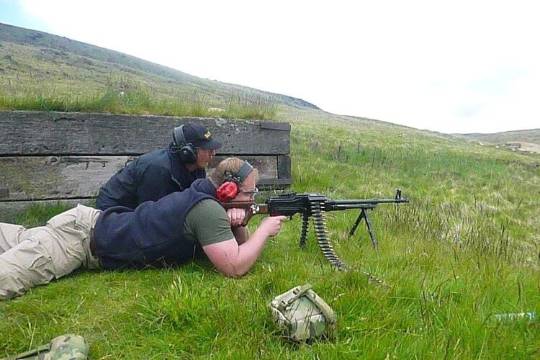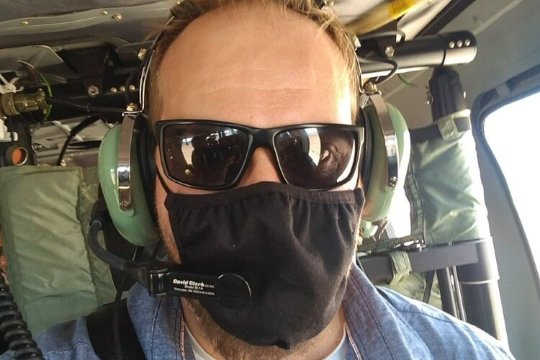#Defence Science & Technology Laboratory (DSTL)
Explore tagged Tumblr posts
Text
Experts Craft Life-Saving 'Robot Medics' For Triage in High-Risk Places
Developed by Researchers at the University of Sheffield, this Revolutionary Technology has the potential to be a life-saving intervention in high-risk places.
— Mrigakshi Dixit | January 19, 2024 | Interesting Engineering

The MediTel Project, Which Includes Two Robotic Arms. University of Sheffield
In environments deemed too hazardous for doctors to access, the use of robot medics becomes a crucial solution.
This fundamental idea has driven the creation of a high-tech vehicle equipped with robotic arms to conduct essential medical triage in perilous situations like humanitarian disasters and conflict zones.
Developed by researchers at the University of Sheffield, this revolutionary technology has the potential to be a life-saving intervention in high-risk places.
Examining Victims Within 20 Minutes
Built upon the innovative "medical telexistence (MediTel) solution," this state-of-the-art mobile robotic-controlled uncrewed ground vehicle (UGV) incorporates virtual reality (VR) technology.
It enables seamless communication with doctors, facilitating the remote execution of critical medical triage and eliminating the necessity for them to put their lives at risk in hazardous situations.
The completely integrated vehicle, which was created in just nine months, is made up of two high-tech robotic arms that can operate medical instruments remotely.
Within 20 minutes, this robotic medic can do a thorough first examination of victims.
This includes checking vital signs such as temperature, blood pressure, and heart rate, palpating the abdomen, and giving pain treatment using an auto-injector. Real-time data is continuously sent to the remote operator during the entire evaluation process.
“Our MediTel project has demonstrated game-changing medical telexistence technology that has the potential to save lives and provide remote assessment and treatment of casualties in high-risk environments such as humanitarian disasters,” said David King, Head of Digital Design at the University’s Advanced Manufacturing Research Centre (AMRC).

Robotic Arms being tested on a Dummy Model. University of Sheffield
“Developing and field testing a state-of-the-art, complex system such as MediTel in just nine months has been an incredible achievement and a testament to the skills and capabilities of the entire project team,” added King, in the press release.
This cutting-edge technology represents a big step forward in improving medical facilities in difficult and life-threatening situations, opening up new avenues for remote healthcare interventions in emergencies.
MediTel was one of three telexistence technologies to obtain financing through a two-phase £2.3 million innovation competition conducted by the Defence and Security Accelerator (DASA). This program was carried out on behalf of joint funders, the Defence Science and Technology Laboratory (DSTL), and the Nuclear Decommissioning Authority.
“Telexistence technologies have the potential to remove end users from harmful environments and/or rapidly insert specialists as required," said Nicky Armstrong, technical lead at Dstl, in the release.
“The prototype technologies developed under the Dstl Telexistence project have enabled us to demonstrate the art of the possible to end users so that we can better understand where telexistence could add value to defense and security environments," Armstrong concluded.
#University of Sheffield | England 🏴#The MediTel Project#Robot Medics#Life Saving Triage#High Rick Places#Revolutionary Technology#Researchers#Defence and Security Accelerator (DASA)#Defence Science & Technology Laboratory (DSTL)
0 notes
Text
by John Helmer, Moscow @bears_with
The British Government’s narrative that Russian military agents, on orders from President Vladimir Putin, used Novichok in Salisbury in March 2018 continues to collapse. A secret chemical warfare agent revealed last week that two tests for Novichok, using special machines provided by the Porton Down chemical warfare laboratory, failed to confirm an organophosphate poison in either Dawn Sturgess or her boyfriend, Charles Rowley.
The agent described himself in his witness statement and in a guarded appearance at the Dawn Sturgess Inquiry last week as a qualified medical doctor and pharmacology expert. “I currently work at Dstl [Defence Science and Technology Laboratory] Porton Down within the Chemical, Biological and Radiological (CBR) Division, and provide medical advice to the Ministry of Defence and other government Departments on CBR related threats… I was Chemical and Biological (CB) Medical Advisor to Dstl and the Operational teams in support of the investigations into the attack on the Skripals (Operation WEDANA) and the investigation into the poisoning of Dawn Sturgess and Charlie Rowley (Operation READ).”
The agent’s name was ordered to be kept secret by the Inquiry chairman and commercial consultant, Anthony Hughes (titled Lord Hughes of Ombersley). This is despite Hughes’s ruling that he would not keep the names secret of “those who were already sufficiently identified publicly in connection with the events of 2018.”
FT49 is the cipher used for the Porton Down agent, although sources claim he has advertised his engagement in the Skripal, Sturgess and Rowley cases in several academic publications accessible on the internet.
In his witness statement dated September 16, 2024, the Porton Down agent revealed that he had organized with doctors at the Salisbury District Hospital (SDH) to test the blood of Sturgess and Rowley, after their admission to the hospital on June 30, 2018, using special biochemical assay machines provided by Porton Down. One of the machines had been installed at SDH during the hospitalisation of Sergei and Yulia Skripal in March of 2018. A second Porton Down machine was in operation at a Birmingham toxicology laboratory.
2 notes
·
View notes
Text
But, But, But, DEWS aren't real…
DragonFire is a British laser directed-energy weapon (LDEW). It was first unveiled to the public as a technology demonstrator in 2017 at the Defence and Security Equipment International (DSEI) conference in London and is being developed by UK DragonFire, a collaboration consisting of MBDA UK, Leonardo UK, QinetiQ and the Defence Science and Technology Laboratory (Dstl).
A production version is expected to enter service in 2027 onboard Royal Navy ships
6 notes
·
View notes
Text
UK Introduces New Measures to Crack Down on AI-Generated Deepfakes

The Growing Threat of Deepfakes The UK government is stepping up efforts to combat AI-generated deepfakes as their spread reaches alarming levels. An estimated eight million deepfake images and videos are expected to circulate in 2025—an exponential rise from 500,000 in 2023. As AI tools become more sophisticated and accessible, the risk of criminal misuse increases, making detection and prevention a top priority.
Government and Industry Collaboration The Accelerated Capability Environment (ACE) is at the forefront of the UK’s deepfake crackdown, bridging the gap between law enforcement and cutting-edge technology firms. In 2024, key collaborations and technological advancements were made to enhance deepfake detection. One of the most notable initiatives was the Deepfake Detection Challenge, launched by the Home Office, Department for Science, Innovation and Technology, ACE, and the Alan Turing Institute. This initiative united academia, industry, and government experts to develop innovative solutions for identifying AI-generated content.
Tech Giants Join the Fight Major technology companies, including Microsoft and Amazon Web Services (AWS), played a pivotal role by supporting the development of deepfake detection tools. A specially designed platform hosted two million assets, both real and AI-generated, to train and test detection models. After weeks of research and development, six teams were selected to present their solutions to over 200 stakeholders. Companies such as Frazer-Nash, Oxford Wave, the University of Southampton, and Naimuri contributed AI-powered detection tools that are now undergoing benchmark testing and real-world trials.
Deepfake Detection in Law Enforcement Law enforcement agencies are also focusing on deepfake detection in criminal investigations. The Defence Science and Technology Laboratory (DSTL) and the Office of the Chief Scientific Adviser (OCSA) have prioritized data-driven solutions to improve AI-powered forensic tools. The challenge is significant—officers handling digital forensics often deal with millions of illicit images on a single device, making AI-driven detection crucial for accelerating investigations.
The EVITA (Evaluating Video, Text, and Audio) AI tool is now being refined to improve deepfake detection within police investigations. The next phase involves commissioning proof-of-concept trials, ensuring these technologies are practical and effective in real-world applications.
The Future of Deepfake Detection The UK’s strategy is evolving rapidly, with an emphasis on collaborative innovation, real-world testing, and user-centric solutions. As the Deepfake Detection Challenge progresses, the focus is shifting toward making AI-powered tools more accessible and reliable for law enforcement and cybersecurity experts.
By strengthening regulations and fostering public-private partnerships, the UK aims to stay ahead of AI-driven misinformation and cyber threats in an increasingly digital world.
0 notes
Text
None of us really know how we would react, or cope if we found ourselves in the midst of a large scale emergency. And hopefully, we will never find out.
A six year study by the Defence Science and Technology Laboratory (Dstl) has concluded that crowds act in an orderly and cooperative manner. Rather than panic and flee, most people try to help others who may be in danger.
1 note
·
View note
Text
QinetiQ realizza il primo team a reazione del Regno Unito tra aereo e drone autonomo QinetiQ ha sperimentato con successo la Crewed-Uncrewed-Teaming del Regno Unito, che combina un aereo con equipaggio e un drone a reazione autonomo. La prova, realizzata in collaborazione con il Defence Science and Technology Laboratory (Dstl), la Royal Navy e l’Air and Space Warfare Centre (ASWC), ha coinvolto un aereo a reazione di QinetiQ a Salisbury e un drone Banshee Jet 80 modificato, lanciato al largo della costa scozzese. Il velivolo a reazione ha assunto il controllo del drone, che ha eseguito una missione a 350 nodi insieme a una serie di droni digitali all’interno di uno sciame replicato virtualmente. Il
#Forze_Aeree#Forze_Armate#Industria_della_Difesa#QinetiQ#Accelerating_Air_Autonomy_Capability_Experimentation#Air_and_Space_Warfare_Centre#Crewed_Uncrewed_Teaming#DSTL#regno_unito#royal_navy
0 notes
Text
Hadean Awarded Contract to Populate British Army Live Virtual and Constructive Training Using AI
Spatial computing company, Hadean, have been awarded competitive funding by the U.K. Defence and Security Accelerator (DASA) to develop and scale a complex and representative synthetic human terrain for British Army simulations. This will take the form of a contract with the U.K. Defence Science and Technology Laboratory (Dstl). The project aims to enhance military training in land environments…

View On WordPress
0 notes
Text
AUKUS Advances AI and Autonomy in Defense Collaboration

A Leap Towards Technological Superiority
The UK's Defence Science and Technology Laboratory (Dstl) and the armed forces, in a groundbreaking collaboration with Australia and the United States, have taken significant strides in the AUKUS trial held in Australia. This trial not only underscores a collective commitment but also signifies a shared determination to harness artificial intelligence (AI) and autonomous systems. Moreover, it promises to redefine the future of military operations, marking a transformative moment in the field of defense technology and cooperation among the three nations.
The Essence of the TORVICE Trial
Addressing Vulnerabilities in Robotic Warfare The AUKUS Trusted Operation of Robotic Vehicles in Contested Environments (TORVICE) trial represents a critical step. Moreover, it is a crucial step toward identifying and mitigating vulnerabilities that affect the operational reliability of robotic vehicles and sensors. By gaining a deeper understanding of these challenges, the AUKUS nations aim to enhance the effectiveness of autonomous systems in future missions. This initiative underscores the commitment to advancing technological solutions for more secure and efficient military operations. A Path to Integration Following the inaugural AUKUS AI and autonomy trial in the UK in April 2023, defense ministers announced plans to integrate Resilient and Autonomous Artificial Intelligence Technologies (RAAIT) into national programs by 2024. The TORVICE trial is a pivotal move towards actualizing this vision, particularly in the land domain.
Trial Highlights
Tested Under Fire In a series of missions, autonomous vehicles from the US and UK demonstrated their capabilities under various adversarial conditions simulated by Australia. This included electronic warfare, laser attacks, and GPS disruptions. The outcomes are expected to bolster the resilience of AUKUS AI and autonomy systems against modern battlefield threats. Expert Insights Guy Powell, Dstl’s technical authority for the trial, emphasized the importance of understanding the robustness of robotic and autonomous systems in contested environments. Similarly, Dstl military advisor, Lt Col Russ Atherton, highlighted the transformative potential of these technologies in expanding operational capabilities and ensuring an operational advantage.
A Tri-Nation Endeavor for Superiority
Enhancing Interoperability and Innovation This tri-nation collaboration facilitates access to resilient AI and autonomy technologies. Furthermore, it streamlines efforts and leverages collective scientific and technological expertise. The TORVICE AI trial is a testament to AUKUS's commitment, highlighting its dedication to improving interoperability and fostering innovation across the defense sector. In essence, this initiative underscores the alliance's drive to enhance its defense capabilities through collaborative endeavors and advanced technology adoption. Security and Stability in the Indo-Pacific AUKUS stands as a landmark defense and security partnership aimed at bolstering security and stability in the Indo-Pacific region and beyond. Through initiatives like the TORVICE trial, the partnership seeks to ensure that allied forces remain equipped to face rapidly evolving threats, adhering to international law while promoting the safe and responsible use of AI. Looking Forward to Implications and Impact The successful execution of the TORVICE trial marks a significant milestone in the AUKUS partnership's journey. Moreover, it represents a pivotal step toward integrating cutting-edge military technologies. By accelerating the development and deployment of AI and autonomous systems, AUKUS nations are poised to achieve a substantial enhancement in coalition military capabilities. This not only reduces risks to warfighters but also ensures a technological edge in the face of evolving global security challenges. In essence, TORVICE exemplifies the collaborative effort to strengthen military readiness and innovation within the alliance. Sources: THX News & Defence Science and Technology Laboratory. Read the full article
#AIindefense#AUKUSAItrials#AUKUScollaboration#autonomousmilitarysystems#defenseinteroperability#Dstlinnovation#Indo-Pacificsecurity#militarytechnologyadvancements#roboticwarfareresilience#TORVICEtrial
0 notes
Photo




Queen Elizabeth II and The Duke of Cambridge during their visit at the Defence Science and Technology Laboratory (Dstl) where they were to view displays of weaponry and tactics used in counter intelligence, a demonstration of a Forensic Explosives Investigation and meet staff who were involved in the Salisbury Novichok incident at Porton Down science park near Salisbury, southern England, on October 15, 2020. Her Majesty and His Royal Highness also formally opened the new Energetics Analysis Centre.
116 notes
·
View notes
Text

Her Majesty The Queen and The Duke of Cambridge open the new Energetics Analysis Centre at the Defence Science and Technology Laboratory (Dstl) at Porton Down science park near Salisbury, England -October 15th 2020.
📷 : Kensington Palace.
#the queen#queen elizabeth#queen elizabeth ii#prince william#duke of cambridge#british royal family#england#2020#october 2020#porton down 2020#porton down#i love this picture so much#the cambridges#my edit
71 notes
·
View notes
Text




Queen Elizabeth II during a visit to the Energetics Analysis Centre at the Defence Science and Technology Laboratory (DSTL) at Porton Down, Wiltshire.
📷PA Images - see more at #Quee
- PA Images (@PAImages) October 15
34 notes
·
View notes
Text
“all 48 people who were due to come into close contact with them were very recently tested for Covid-19 by Dstl beforehand, and all came back negative, and social distancing was carried out during the visit.”
like the article says directly after this quote, the queen should be wearing one anyway. not only because she’s old but also to set the example. because as i’ve seen, it’s obvious not many people knew she wasn’t wearing one because everyone had been tested. instead it looks like she’s above wearing a mask.
a bad look. they BRF continues to not have a smart PR person
28 notes
·
View notes
Photo

Innovation in Anti-Armor Systems
The British Army is interested in gaining more accurate, long-range engagement capabilities against armoured and non-armoured targets. The Defence Science and Technology Laboratory (Dstl) has unveiled the requirements for its future Battle Group Organic Anti-Armour (BGOAA) project, which aims
https://i-hls.com/archives/108441
#anti armor#UK military#Air & Missile Defense#Ballistic#Military#News#Security#Technology News#UK
1 note
·
View note
Text
Queen carries out her first major royal engagement since before lockdown as she joins Prince William at Salisbury laboratory that dealt with Novichok attack
Queen carries out her first major royal engagement since before lockdown as she joins Prince William at Salisbury laboratory that dealt with Novichok attack
The 94-year-old monarch was joined by her grandson the Duke of Cambridge
They visited Defence Science and Technology Laboratory (Dstl) at Porton Down
First time the Queen has ventured from a royal residence and her ‘HMS Bubble’
[contentcards url=”https://www.dailymail.co.uk/news/article-8843163/Queen-carries-public-royal-engagement-lockdown.html” target=”_blank”]
View On WordPress
5 notes
·
View notes
Text
RBSL Awarded Contract to Deliver New Modular Armour System on Challenger 3.
The Challenger 3 programme has reached an important milestone. The contract has now been signed for Rheinmetall BAE Systems Land (RBSL) to deliver a new modular armour system on the Challenger 3 Main Battle Tank. Designed by world leading armour experts at Defence Science and Technology Laboratory (DSTL), and jointly developed with RBSL, the new modular armour provides a step change in survivability for the Main Battle Tank. With initial integration trials conducted in 2023, RBSL will now test, manufacture and integrate the new armour onto the Challenger 3 tanks. The enhanced survivability will provide enhanced protection for British soldiers against the most dangerous threats Challenger 3 will face. The investment in this critical capability will deliver for the British Army now and into the future. Challenger 3 will be a key component of the Army’s Future Armoured Brigade Combat Teams and the UK’s contribution to NATO deterrence. The investment in this critical capability will ensure that Challenger 3 is a key component of the Army’s future Armoured Brigade Combat Teams and the UK’s contribution to NATO deterrence now and into the future.
The Challenger 3 programme has reached an important milestone. The contract has now been signed for Rheinmetall BAE Systems Land (RBSL) to deliver a new modular armour system on the Challenger 3 Main Battle Tank. Designed by world leading armour experts at Defence Science and Technology Laboratory (DSTL), and jointly developed with RBSL, the new modular armour provides a step change in…

View On WordPress
0 notes
Text
Stuart Lyle: Revolutionizing Urban Warfare

A Vanguard of Modern Combat
Stuart Lyle often hailed as the British Jack Ryan, is a pivotal figure reshaping the landscape of urban warfare. With over a decade at the Defence Science and Technology Laboratory (Dstl), Lyle's journey is a testament to the profound impact of blending critical research with practical military applications. Furthermore, his work is not just about theories; it's about tangible changes that enhance the operational capabilities of the British Army and Royal Marines. In this article, we will delve into how Lyle and his team's contributions are setting new standards in military strategy and execution.

Stuart Lyle on exercise. Photo by DOD.
Shaping the Future of Urban Combat
Bridging the Gap Between Theory and Practice Lyle's dedication to transforming theoretical research into actionable strategies is evident in his and his team's approach to military innovation. Their work, spanning various projects, is all aimed at giving the UK's armed forces an edge in increasingly complex urban environments. Lyle further emphasizes the rewarding nature of seeing his team's recommendations come to life, thus influencing everything from organizational structures to equipment procurement. A Team Effort The success behind Lyle's projects is a testament to the collaborative spirit of his team. Specializing in urban warfare, Lyle relies on the diverse expertise within his group to inform and enhance his strategies. This multidisciplinary approach not only ensures a comprehensive understanding of combat challenges but also leads to more effective solutions.

Stuart Lyle at Copehill Down. Photo by MOD.
Innovations in Urban Warfare
The Urban Phalanx Platoon Concept One of Lyle's notable contributions is the development of the Urban Phalanx platoon concept. Originating from Dstl's extensive research, this innovative strategy aims to improve the survivability and effectiveness of infantry units in urban settings. Furthermore, by proposing a new unit configuration, Lyle's team directly addressed the unique challenges of urban combat, thereby enhancing situational awareness and easing the command burden on junior leaders. Towards a Next-Generation Combat Team The British Army's Experimentation and Trials Group has embraced the Urban Phalanx concept as a foundation for the Next Generation Combat Team. This endorsement not only underscores the potential of Lyle's work to redefine urban warfare but also actively showcases the concept in international forums and live trials.

Stuart Lyle being interviewed at DSEI with Dstl colleagues. Photo by MOD.
The Man Behind the Innovation
A Career Reflective of a Fictional Hero Lyle's career trajectory mirrors that of Tom Clancy's Jack Ryan, earning him the nickname among US colleagues. Despite a pivot from a potential military career due to a back injury, Lyle found his calling in defense analysis, contributing to the UK's military prowess while engaging with global partners and sharing his insights worldwide. Personal Passions and Professional Drive Outside of his groundbreaking work, Lyle finds solace in hobbies such as wargaming and camping, showcasing his multifaceted personality. Moreover, his unexpected talent in baking, developed from making novelty cakes for his children, highlights his creativity and dedication to excellence, traits that extend to his professional life.

Stuart Lyle in a helicopter above LA. Photo by MOD.
A Legacy of Influence
Stuart Lyle's contributions to urban warfare strategy are reshaping the way military operations are conducted in urban environments. His work not only provides the UK's armed forces with an operational advantage but also sets a global standard for excellence in military strategy and innovation. Additionally, as Lyle continues to share his knowledge and insights across the world, his legacy as a modern-day British Jack Ryan grows, underscoring the critical role of research and collaboration in the future of defense. Sources: THX News & Defence Science and Technology Laboratory. Read the full article
#BritishArmy#DefenceScienceandTechnologyLaboratory#Dstlresearch#MilitaryInnovation#NextGenerationCombatTeam#Operationaleffectiveness#StuartLyle#Urbancombatstrategy#UrbanPhalanxplatoon#Urbanwarfare
0 notes